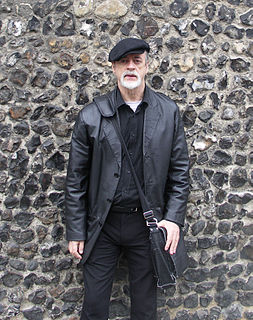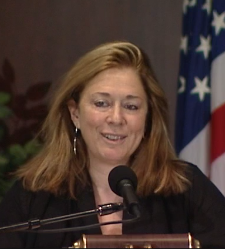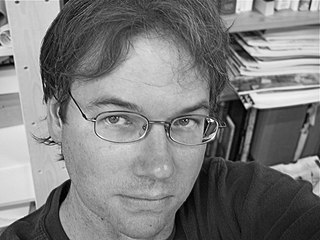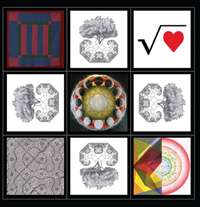Related Research Articles
Allen Fisher is a poet, painter, publisher, teacher and performer associated with the British Poetry Revival.
Frank C. Moore II was a New York-based painter, winner of the Logan Medal of the Arts, and a member of the Visual AIDS Artist Caucus—the organization responsible for the (Red) Ribbon Project, A Day Without Art, and A Night Without Light.
David Lehman is an American poet, non-fiction writer, and literary critic, and the founder and series editor for The Best American Poetry. He was a writer and freelance journalist for fifteen years, writing for such publications as Newsweek, The Wall Street Journal, and The New York Times. In 2006, Lehman served as Editor for the new Oxford Book of American Poetry. He taught and was the Poetry Coordinator at The New School in New York City until May 2018.

William Lewis is an English artist, story-teller, poet and mythographer. He was a founder-member of The Medway Poets and of the Stuckists art group.

Jorie Graham is an American poet. The Poetry Foundation called Graham "one of the most celebrated poets of the American post-war generation." She replaced poet Seamus Heaney as Boylston Professor of Rhetoric and Oratory at Harvard, becoming the first woman to be appointed to this position. She won the Pulitzer Prize for Poetry (1996) for The Dream of the Unified Field: Selected Poems 1974-1994 and was chancellor of the Academy of American Poets from 1997 to 2003. She won the 2013 International Nonino Prize in Italy.
The University of Georgia Press or UGA Press is a scholarly publishing house being the publishing division of the University of Georgia. It is the oldest and largest publishing house in Georgia and a member of the Association of American University Presses.
Pierre Coupey is a Canadian painter, poet, and editor.

Anh Duong is a French-American artist, actress, and model. She is known for her self-portraits, which she has compared to a visual diary, as well as portraits of significant art collectors and influencers.

Otto Piene was a German-American artist specializing in kinetic and technology-based art, often working collaboratively. He lived and worked in Düsseldorf, Germany; Cambridge, Massachusetts; and Groton, Massachusetts.
Foetry.com, sometimes referred to as just Foetry, was a website that attempted to identify fraudulent and unethical practices in poetry contests. It was active from April 1, 2004 until May 18, 2007.

Susan Charna Rothenberg was an American contemporary painter, printmaker, sculptor, and draughtswoman. She became known as an artist through her iconic images of the horse, which synthesized the opposing forces of abstraction and representation.

Clarence Major is an American poet, painter, and novelist; winner of the 2015 "Lifetime Achievement Award in the Fine Arts", presented by the Congressional Black Caucus Foundation. He was awarded the 2016 PEN Oakland/Reginald Lockett Lifetime Achievement Award.
Carolyn Mary Kleefeld is an English-born American author, poet, and visual artist. She is the author of twenty-five books, has a line of fine art cards, and has had numerous gallery and museum awards and exhibitions between 1981 and the present, in New York City, Chicago, Los Angeles, San Francisco, and other major cities.

Greg Colson is an American artist best known for works that straddle the line between painting and sculpture that address concepts of efficiency and order. Using scavenged materials, Colson allows the physicality of his makeshift constructions to intrude on the precise systems he paints or draws upon their surfaces - striking a balance between subject and context, image and support, order and chaos.

Robert Carleton Hobbs is an art historian and curator specializing in twentieth-century art. Since 1991 he has held the Rhoda Thalhimer Endowed Chair of American Art in the School of Arts, Virginia Commonwealth University, a highly ranked art department. Since 2004 he has served as a visiting professor at Yale University. He has held positions at Cornell University, University of Iowa, Florida State University, and Tehran Museum of Contemporary Art in Iran, and is known for a number of books, in-depth essays, and exhibitions.
Nabil Nahas is a Lebanese artist and painter living in New York.
Edwin James ('Peter') Wilson is an Australian poet, painter, and lapsed scientist, with a strong interest in history. Born: 27 October 1942, Lismore, New South Wales

Amitabh Mitra is an Indian-born South African physician, poet and artist, whose paintings depict dramatised stick figures.

Duilio Cambellotti was an Italian applied artist, illustrator, painter, sculptor and designer who played a role in the Arts & Crafts and Art Nouveau movements, and whose influence was social and political as well as aesthetic and artistic. He is recognized for his versatility across a spectrum of visual and design disciplines, and for his fidelity to agrarian themes.

Rhythm of Structure is a multimedia interdisciplinary project founded in 2003. It features a series of exhibitions, performances, and academic projects that explore the interconnecting structures and process of mathematics and art, and language, as way to advance a movement of mathematical expression across the arts, across creative collaborative communities celebrating the rhythm and patterns of both ideas of the mind and the physical reality of nature.
References
- ↑ "An Artist's Archeology of the Mind". The New Yorker . 18 March 2019.
- ↑ Joshua Rothman, "An Artist's Archeology of the Mind," The New Yorker , March 18, 2019.
- ↑ "Swimming in Words", Harvard Gazette
- ↑ "Peter Sacks". english.fas.harvard.edu. Retrieved 6 October 2017.
- ↑ "Peter Sacks". petersacks.com. Retrieved 7 September 2018.
- ↑ Photographs and discussion of Sacks's artworks Archived 19 October 2007 at the Wayback Machine , Galerie piece unique
- ↑ "Republic - at Sperone Westwater 22 January – 13 March 2021 | Peter Sacks".
- 1 2 Bloch, Talia (November 2012). "Peter Sacks: New Paintings". The Brooklyn Rail.
- ↑ Merkin, Daphne (19 December 2012). "Where a Thousand Words Paint a Picture". The New York Times.
- ↑ Lerner, Ben (11 January 2013). "Peter Sacks". Art in America.
- ↑ "Peter Sacks: Migrations". Issuu. Retrieved 5 September 2018.
- ↑ Kurchanova, Natasha. "Peter Sacks interview: 'Every painting has its own secret story', Studio International". Studio International - Visual Arts, Design and Architecture. Retrieved 5 September 2018.
- ↑ "MutualArt.com - The Web's Largest Art Information Service". www.mutualart.com. Retrieved 5 September 2018.
- ↑ Foetry.com archive Archived 13 June 2007 at the Wayback Machine
- ↑ Foetry page on Jorie Graham
- 1 2 Alex Beam, "Website polices rhymes and misdemeanors," Boston Globe, 31 March 2005, available here
- 1 2 3 Tomas Alex Tizon, "In Search of Poetic Justice," Los Angeles Times, 17 June 2005. Available at the LA Times (subscription needed). Text is available at New Poetry Review Archived 25 July 2012 at the Wayback Machine or SFgate (accessed 16 March 2007)
- ↑ "Necessity | W. W. Norton & Company". books.wwnorton.com. Retrieved 7 September 2018.
- ↑ Program announcement Archived 27 August 2007 at the Wayback Machine , Folger Shakespeare Library